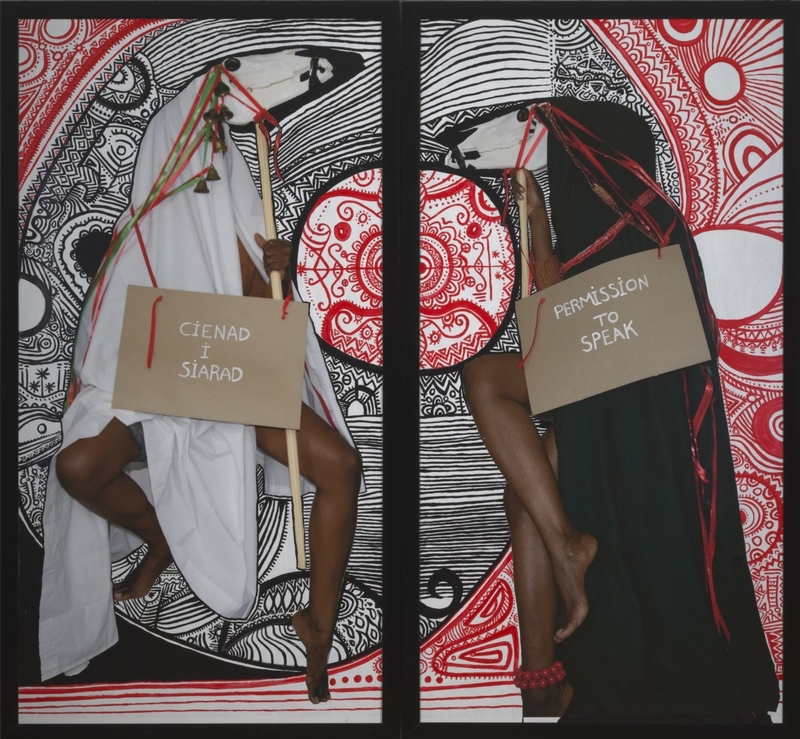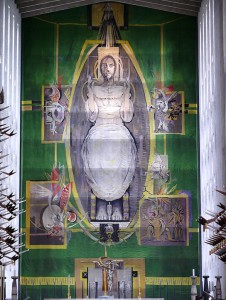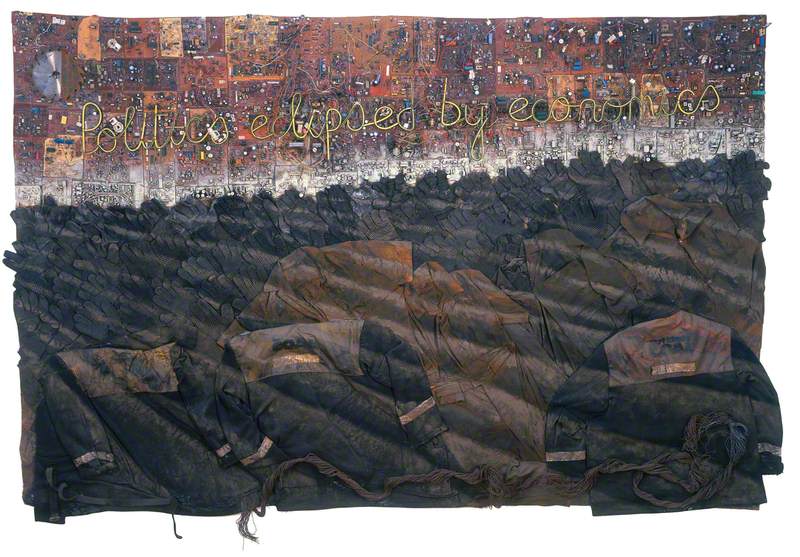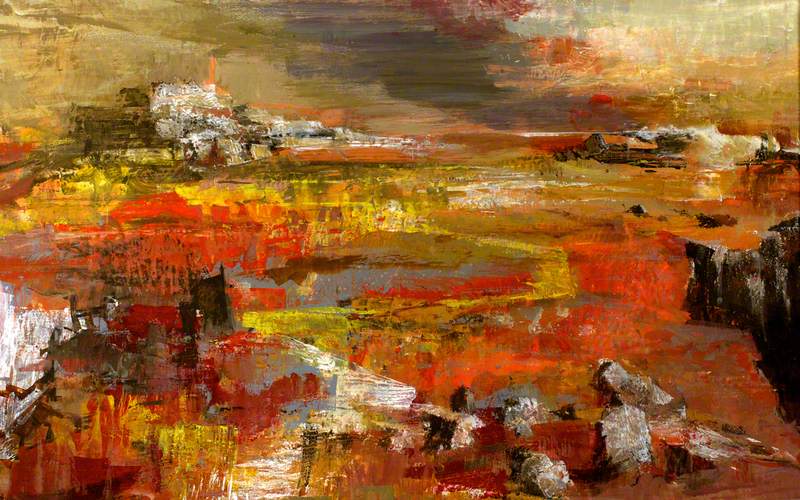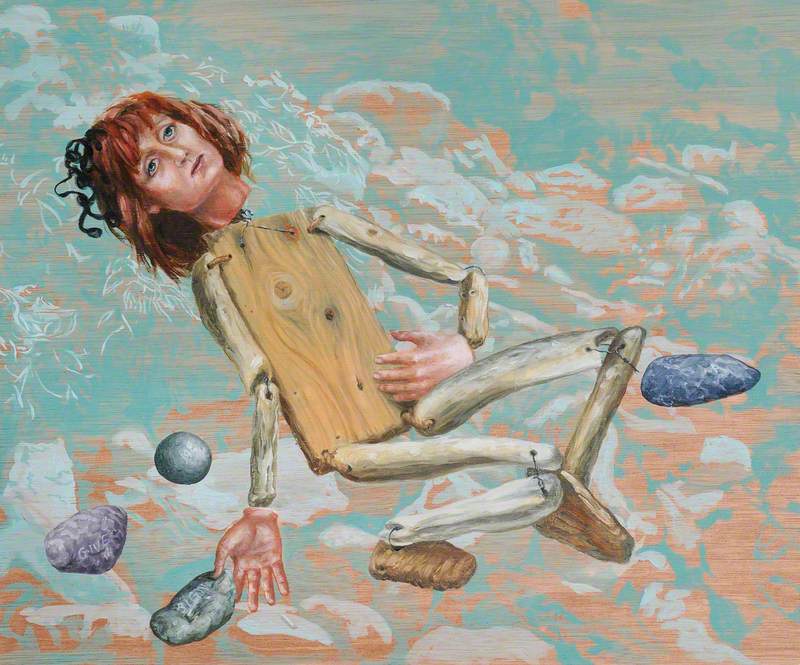Romanticism has swept in waves across landscape art – during the Romantic era, in the mid-twentieth century and in a continuing tradition today. In Wales, Breconshire is a famously 'Romantic' county, dominated by the windswept Brecon Beacons and the Black Mountains, the upper Wye and the waterfall country of the River Neath. In the early Middle Ages, it was the kingdom of Brycheiniog. As a fertile place for Romantic landscape art, it is represented not just in local collections but around the world.
Romanticism began in the late eighteenth and nineteenth centuries as a response to nature, imagination and feeling. William Vaughan describes it as emphasising the 'associative side of picture-making' in contrast with classical art that emphasised 'formal values'. The Welsh artist Richard Wilson came from a classical tradition of painting in the Grand Manner yet John Ruskin called him the father of 'sincere landscape art founded on a meditative love of nature'. In Llyn-y-Cau, Cader Idris, he created probably the first painting ever set amid mountains, perhaps taking a cue from Edmund Burke's ideas of the dangerous and 'sublime' as an alternative to beauty.
While Wilson seems not to have painted in Breconshire, one of his pupils was Thomas Jones of Pencerrig, on the Breconshire-Radnorshire border, who brought Wilson's sincerity to the landscapes that he loved. The Vale of Pencerrig shows the view from the Carneddau ridge. Like his master, Jones climbed into the 'wastes', from which he could see as far as the Black Mountains.
A generation of visiting artists discovered Wales when the French Wars made the Grand Tour all but impossible. They were attracted by its wildness and strangeness, the vastness of the mountains and its different language and history. They were also drawn by William Gilpin's theories, which valued the irregular and wild above the symmetrical and well-tended. On arriving, many were of an age when new influences could be transformative (J. M. W. Turner was 17, John Sell Cotman 18) and most were seeing mountain streams and rocky slopes for the first time in their lives.
Turner drew at Crickhowell, Tretower and Brecon, where his watercolour quits the visible life of the town for the underworld of the shaded riverbanks, overlooked by the silhouetted ruins of the castle. Cotman, drawing the same scene in 1803, was learning to simplify in areas of flat tone and made the further bridge a startling brightness.
Brecon Bridge
c.1803, gray & black wash over graphite on paper by John Sell Cotman (1742–1842) 
It was rare for female artists to take painting tours, but one who passed through Breconshire was Amelia de Suffren, a French aristocrat exiled by the Revolution who published aquatints in 1802 as A Picturesque Journey around South and North Wales. Her view of the Clydach Gorge juxtaposed the works of nature and man: a waterwheel in trees and hills rescaled to the grandeur of the Alps above the labourers.
Brick Kiln at Clydach, Monmouthshire
c.1795, aquatint by Amelia de Suffren 
Interior of the Cave at Porth yr Ogof
1819
Thomas Hornor (1785–1844) 
A succession of artists discovered Breconshire's waterfall district. Thomas Hornor produced dreamlike images along the rivers, including Interior of the Cave at Porth yr Ogof. The teenage Penry Williams of Merthyr Tydfil lent the waterfalls a moody grandeur, before he moved to Rome and his paintings became firmly Neoclassical.
Eionon Garn on the Perddyn or Ysgwd or Scwd Fall, Neath Valley
1819
Penry Williams (1802–1885) 
A retreat from Romanticism began in the late nineteenth century. It was not until the 1930s that a generation of Neo-Romantic artists set off a new wave of emotional response to landscape, reinvigorated by Expressionism, Surrealism and abstraction. Graham Sutherland's work was transformed in Pembrokeshire but soon afterwards he found the opencast mines on the border of Breconshire, where he watched as mountain strata were torn open by monster-like machines.
Outcast Coal Production – Depositing Earth from Buckets
1943
Graham Vivian Sutherland (1903–1980) 
David Jones' response to a Breconshire landscape can be seen as an earlier glimmer of Neo-Romanticism. He came regularly to Capel-y-ffin in the Llanthony valley in 1924–1927 and was moved by the rhythms of hills and streams and his sense of the land's connections to ancient literature and his father's Welsh roots. The valley haunted his imagination for the rest of his life. His last completed painting, Y Cyfarchiad i Fair, was set in the hills of Capel.
The Annunciation in a Welsh Hill Setting
1962–1963
David Jones (1895–1974) 
Eric Ravilious followed in Jones' footsteps in 1938. He captured a frisson of strangeness and a breath of the sublime in the scale of his landscapes. He wrote, 'the hills are so massive it's difficult to leave room for them on the paper'.
Wet Afternoon, Capel-y-ffin
c.1938, watercolour & pencil on paper by Eric Ravilious (1903–1942), private collection 
His friends John and Myfanwy Piper came to visit and John returned to paint ruined cottages. The Romantic motif of the abandoned home, whitewash glimmering against the darkness, is transformed by a modernist's eye for abstract form and texture.
A final location where Neo-Romanticism flourished was the coalfield village of Ystradgynlais. The Polish refugee Josef Herman came for a holiday in 1944 and stayed eleven years. He recognised immediately a place that would feed his imagination and began making paintings of the miners, the black spoil tips and the huddled houses. The language of Herman's paintings derived from Belgian Expressionism but in Breconshire it found a Romantic accent thanks to the enfolding landscape and the community that accepted him.
'Pen-y-Bont Inn', Ystradgynlais
c.1949
Josef Herman (1911–2000) 
Within a decade, British art was rocked by the arrival of American Abstract Expressionism and other movements. Nevertheless, individual artists continued with Romantic concerns, whether for the resurgence of nature, continuity with the past or the power of some environments. Former industrial areas on the southern edge of the county have attracted several artists. Bert Isaac found rich subject matter in nature's renewal of abandoned quarries and coal tips. Dick Chappell uses abrasion and sgraffito to evoke the broken, exploited hillsides.
Artists have found richly associative themes in the centre of the county too. On the hillsides of the Usk valley, Robert Macdonald makes paintings steeped in the unseen as well as the visible, portraying the living world around him and the turning of the seasons.
Overlooking Parcside and Wernfawr
1993, watercolour by Robert Macdonald (b.1935) 
Ivor Davies used soil from the Epynt army firing range in a painting of a mountain farm consumed by shell fire, and invoked the Celtic god of thunder, Taranis, to express his fury at the eviction of communities.
Clive Hicks-Jenkins allied the Breconshire landscape with folk custom and personal history, transforming the castle at Tretower into a sentinel in pictures prompted by his late father's terror of the mumming tradition of the Mari Lwyd.
Deposition III
2002, Conté by Clive Hicks-Jenkins (b.1951), National Library of Wales, Aberystwyth 
Today, Breconshire-based artists in many media continue to engage with the meanings and associations of the landscape. Pip Woolf explores emotional and political questions for the environment; in 2023 Penny Hallas and Susan Adams began a project to respond to the hidden stories of the derelict mid-Wales psychiatric hospital. The Romantic tradition still finds inspiration in the Breconshire landscape after 250 years.
Peter Wakelin, writer and curator
This content has been supported by Welsh Government funding
Further reading
Peter Wakelin, 'Breconshire Landscapes and the Romantic Tradition in Painting', Brycheiniog, the journal of the Brecknock Society, volume 55, March 2024
Edmund Burke, A Philosophical Enquiry into the Origins of our Ideas of the Sublime and Beautiful, 1757
William Vaughan, Romantic Art, Thames & Hudson, 1978
William Gilpin, Observations on the River Wye, and Several Parts of South Wales, etc. Relative Chiefly to Picturesque Beauty; made in the Summer of the Year 1770, 1782










